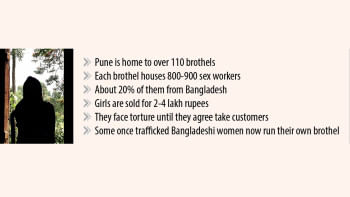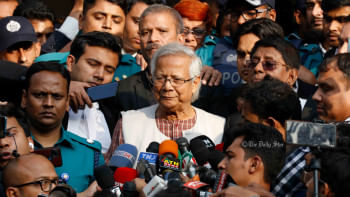Bombaypara in Narail: a sex trafficking hotspot

Every year, many girls are trafficked out of Bangladesh with the promise of a better life abroad, only to end up in the underbelly of cities like Mumbai and Pune, India. An investigation by The Daily Star takes a look into this dark world that involves brokers, traffickers and law enforcers on both sides of the border. This is the third part of a four-part series.
Two hours away from Jhenaidah's Indo-Bangla border, the district of Narail has gained a notoriety for being one of the biggest sources of girls headed for Mumbai.
The district's hot pockets include Jamrildanga, Badamtola, Khararia, Bhogra, and Tularampur.
This deeply concerning situation has even led to the designation of an entire area within the Narail district as "Bombaypara."
During an on-site investigation, locals said that over the years, a considerable number of girls and women from these areas have left their homes with aspirations of working as domestic help in Bombay [now Mumbai], India.
Abdur Rahman, a resident of Jamrildanga in Narail, said it is common for these girls to return home after a span of one or two years.
"During their return, these girls often take one or two girls with them to Bombay for employment. This practice has created a sense of unity and mutual support among the villagers, prompting them to affectionately refer to the locality as Bombaypara," he said.
Part-1: Lured to India's red light district, and a lucky escape
Part-2: Sex Trafficking: The racket on prowl at the border
Part-4: No coming home
The Daily Star found a woman named Mohona, who was in the midst of preparations to embark on a journey to Mumbai, leaving her two children under the care of her husband.
"I got a job offer from two women in Khararia village. They assured me of my success and good earnings," she said in May.
Pakhi, the sex worker in Pune, said one of the most popular Bangladeshi brothel managers runs around 25 brothels, housing as many as 100 Bangladeshi girls. Most of them are from Shingsholpur area of Narail.

THE MONEY TRAIL IN INDIA
"Earlier, we used to see that the traffickers or their partners would bring the survivors right from the village to the destination," said a source in Mumbai, who has been aiding law enforcers in conducting raids, searches, and rescue operations since 2006.
The person, requesting anonymity, said, "Now, they bring the girls to the Bangladesh border, cross the border at night in areas with less vigilance, and then they either bring them to the destination or keep them in some villages around the border till the deal is finalised. So, there are multiple people at different stages -- multiple buyers and multiple sellers."
According to the source, these deals are all settled by cash payment.
"We witnessed girls aged between 11 and 14 years old being trafficked from Bangladesh, and the proportion is not less than 30 percent," the person told The Daily Star.
SM Azharul Islam, a programme manager of Rights Jashore, said the tactic these days is to force the trafficked girl to marry a Bangalee man to ensure legal stay in India.
"Once the marriage is completed, the girl is handed over to a brothel or a flat and forced to do sex work," explained Azhar, who has been rescuing trafficked girls for over a decade.
Azhar said the person who first convinces a girl to travel to India receives Tk 15,000.
At the border, syndicate members receive and guide the girls, using motorbikes to navigate the treacherous path.
"The transport worker responsible for carrying the girl to the border receives Tk 10,000. Then the person who receives and shelters the girl gets between Tk 10,000 and 15,000," he said.
The houses on the border that shelter the girl, receive Tk 3,000 for the service, he said, adding, "The girl needs to stay in the house until the border is 'green' for the illegal crossing."
The carrier nowadays charges Tk 15,000-20,000 for taking the girl to India often under the nose of the security forces, said Azhar, the NGO worker.
"Similarly, the host on the Indian side receives Tk 10,000-15,000 for keeping and transporting the girl to rail stations for the journey to Mumbai," he said.
Azharul further said the transport worker in the rail service receives Tk 7,000 for taking the girl to Mumbai and providing security.
"Finally, the person who receives the girl in Mumbai and sells her to the brothel gets around Tk 3 lakh," Azhar added.
According to the source in Mumbai, some Bangladeshi people are now living in Pune and different districts of Maharashtra as Indians, and a section of them was found involved with trafficking rackets along with the Indian traffickers.
"For setting up a brothel, the pimp first rents a house, and appoints Bangladeshis as managers to convince the girls," the source told The Daily Star.
"We are now witnessing that the brothels are run in apartments in Maharashtra."
These pimps manage the local administration by paying bribes, locally called hafta.
"There are separate people for showing girls' pictures to customers, collecting the rent, providing security, managing the police, and transporting the girls to customers," the source explained.
"The monthly payment [bribe] is around 50,000 rupees. A share of the money also goes to the pockets of local political leaders," the source alleged.
In exchange for the payment, police often work as associates of the brothel managers, he said.
"We have multiple cases where we found that the victim managed to flee from the brothel and tried to get help from local police. But the police instead of extending support informed the brothel managers and then handed over the girls to the brothel again."

 For all latest news, follow The Daily Star's Google News channel.
For all latest news, follow The Daily Star's Google News channel. 











Comments